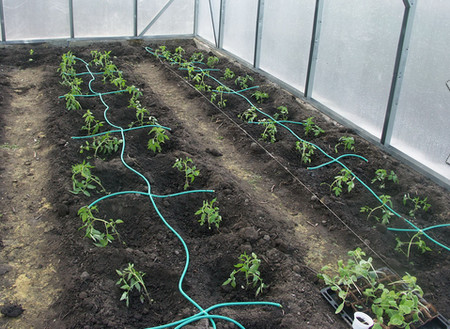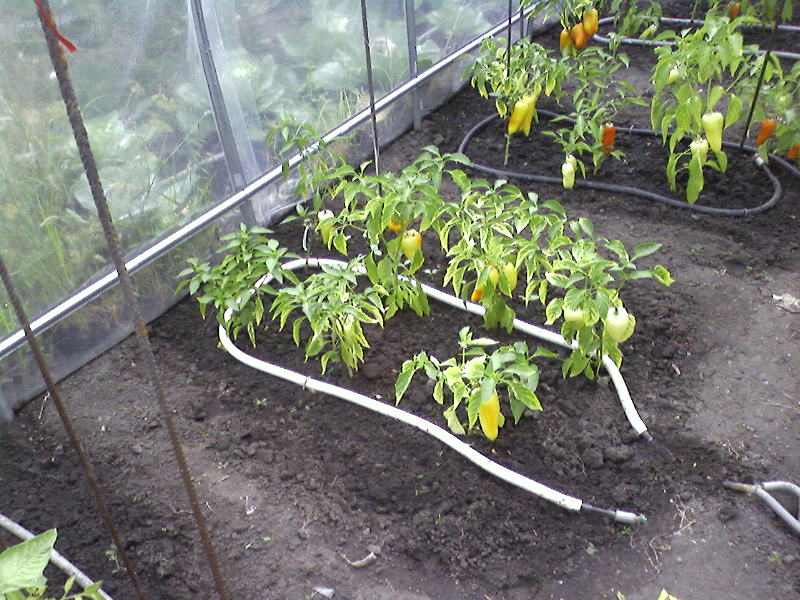How to organize watering in a polycarbonate greenhouse
Content
Drip irrigation and its features
This irrigation method was initially used only in large-scale industries. After this method worked well in large-scale irrigation, it quickly spread, and simple farmers began to use it. Now this unique method is available not only on large farms, but also among ordinary gardeners who grow products in a greenhouse on a non-commercial basis.
What are the main advantages
For drip irrigation, you can purchase a pre-made beetle or cicle drip kit and moisten the soil right next to the root of the plant. Thus, the plant receives the necessary amount of moisture, and the ground around it remains sufficiently dry. Such distribution of water excludes the possibility of formation of waterlogged land on the site. The unique beetle system can affect not only the plants, but also the neatness of the garden, since the weeds practically do not get water with drip irrigation.
The beetle-type drip irrigation system, unlike traditional irrigation systems, greatly facilitates the work of farmers, since there is no need to loosen the soil from the crust after such irrigation. This system is suitable for those who care about economic water consumption, as its costs are reduced by 20-80%. It depends on the type of soil, climate, plant species and other factors. During the irrigation process, all plants receive the same amount of water, as it is automatically distributed equally across all rows.
It is worth noting that the set of fertilizers obtained by plants in this way is better absorbed by them and absorbed faster. In addition to this, you also use fertilizer sparingly, distributing it only on the plants you need, and not on the weeds growing next to it.
Such a watering device is able to develop the root system of a plant, and, on the contrary, leave the leaves small, thereby preventing them from drying out and various diseases.
The automatic irrigation system in beetle or cicle greenhouses significantly reduces the amount of labor required to care for plants. Irrigation can now be performed at any time of the day. You no longer need to run around with hoses, get your hands dirty and watch the amount of water in the grooves. You just now have to clean the filters that the device contains every day. You have a unique opportunity to make your greenhouse plant care more effective with your own hands.
How to organize drip irrigation yourself
Some inexperienced gardeners are of the opinion that making a beetle or cicle watering kit with your own hands is as easy as shelling pears. You take a hose, make holes in it, and run water through it. That's all. However, with this approach, it will immediately become noticeable that the water is not evenly distributed at all, at the beginning of the hose a huge pressure creates powerful jets of water, and at the end the water flows out drop by drop. This can only remotely resemble drip irrigation.With the proper organization of the irrigation system, water will flow evenly into each plant. Therefore, by purchasing a set "beetle" for a greenhouse, you are guaranteed to receive high-quality irrigation.
In order to do drip irrigation in the greenhouse with your own hands, you initially need a water supply source. For this, a well, a water supply system or a large container, raised to a height of about one and a half meters, is suitable. It is best not to use an open pond for these purposes, as algae and debris that has got into it can clog your irrigation droppers.
The distribution pipe should be at least 3.2 m in diameter. For a simple design of greenhouse irrigation, a regular hose is also suitable. The only requirements for it will be rigidity. The durable hose will not warp from heat on the sunniest days. Another indispensable element included in the do-it-yourself drip irrigation kit is a filter. It is not worth saving on it in order to avoid replacing all hoses after a few years. There are several types of filters.
The most budgetary is a mesh filter. It is quite possible for them to do it for simple do-it-yourself drip irrigation. When buying this filter, you must first of all pay attention to the mesh. The cells of such a stack must be at least 130 microns. Thus, large impurities will not be able to enter the irrigation system. To organize drip irrigation with your own hands, you will also need drip tapes to mount drippers in them, as well as fittings that will connect these tapes to the distribution pipe. These devices can be equipped with taps, with the help of which it is easy and convenient to regulate the amount of moisture. When buying a set of beetle drip irrigation system components, do not forget about special plugs, couplings, tees and more.
To date, to ensure high-quality do-it-yourself irrigation and uniform distribution of moisture, two types of droppers have been developed: external and built-in.
Built-in drippers are located inside the hose itself. They are manufactured in factories and are oval or cylindrical in shape. The productivity of such a device is from 0.5 to 6 liters per hour. Such droppers are indispensable for long beams and difficult terrain. There are also several varieties of external droppers. They are available with adjustable and unregulated water volumes. These droppers are capable of pouring up to seventy liters of water in an hour. Regardless of the variety of external drippers, they are mounted in the pipe in the same way.
For an automatic greenhouse irrigation system, you may need special sensors, controllers, and valves. A set of these elements will be able to make watering of the highest quality and most economical. We also advise you to create a project and make the necessary calculations of water consumption before installing a drip irrigation system in a greenhouse.
Video "Drip Irrigation System"
System follow-up
If you approach the creation of a drip irrigation system in your greenhouse with all responsibility, then with proper care, this device can serve you for a long time. The main negative factor that can eventually disable the system is its pollution. Therefore, the farmer using this irrigation method must take the necessary cleaning measures at the end of each season. It is also worth taking care that the water source is as clean as possible.
Do not forget that the system can become clogged not only by bacteria, but also by zooplankton - unicellular organisms, worms, insects and others. This can cause a blockage in the pipes included in the kit that makes up the irrigation system. Apply chemical and mechanical cleaning to your irrigation regularly. Thus, a do-it-yourself irrigation device can last you longer.
Video "How to set up the system"
Watering with a drip system is a very complex process, therefore, in order to establish it as efficiently and reliably as possible, you should familiarize yourself with all possible nuances. You can do this by watching the video.





